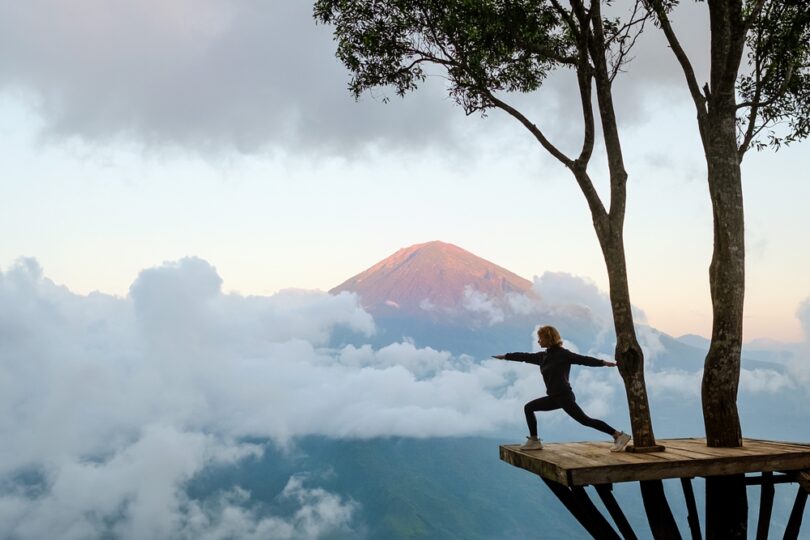India, the birthplace of yoga, is an oasis for those craving a deep, transformative experience. With its rich culture, stunning landscapes, and abundance of spiritual centers, India is the perfect backdrop for a journey toward wellness and self-discovery.
Whether you’re a seasoned yogi or just starting your yoga journey, this guide will take you through the best yoga retreats in India, offering valuable tips, recommending what to wear, and highlighting essential precautions for an enriching experience.
Why Choose India?
 India’s connection with yoga goes back thousands of years, making it an ideal destination for a yoga retreat. With numerous ashrams and centers dedicated to preserving ancient traditions, you can immerse yourself in authentic yoga practices. Picture yourself in Rishikesh, the “Yoga Capital of the World,” or in Kerala, with its serene backwaters and Ayurvedic healing. These are just a couple of the many spots where you can dive deep into yoga.
India’s connection with yoga goes back thousands of years, making it an ideal destination for a yoga retreat. With numerous ashrams and centers dedicated to preserving ancient traditions, you can immerse yourself in authentic yoga practices. Picture yourself in Rishikesh, the “Yoga Capital of the World,” or in Kerala, with its serene backwaters and Ayurvedic healing. These are just a couple of the many spots where you can dive deep into yoga.
From the majestic Himalayas to the tranquil beaches of Goa, India’s diverse landscapes provide the perfect backdrop for a yoga retreat. Imagine practicing yoga surrounded by the lush greenery of Kerala, meditating by the Ganges River in Rishikesh, or enjoying the coastal breeze in Goa. Each location offers a distinctive experience that caters to different tastes and needs.
Choosing the Right Yoga Retreat
First, decide what you’re hoping to get out of your yoga retreat. Are you after a spiritual awakening, a boost in physical fitness, or maybe a mix of both? Knowing your goals will help you pick a retreat that matches your expectations. Next, do some homework on the instructors. The quality of your experience largely hinges on their expertise, so look for retreats with experienced, certified teachers. Reading reviews can give you valuable insights into what past attendees thought.
When it comes to location, think about what environment will help you relax and reflect the most. Whether it’s the tranquil mountains, sunny beaches, or peaceful countryside, choose a setting that feels right for you. Lastly, check the retreat’s schedule. Some programs are packed with multiple sessions each day, while others take a more laid-back approach. Pick a schedule that fits your energy levels and how intense you want your retreat experience to be.

Popular Indian Yoga Styles
India, the birthplace of yoga, offers a rich tapestry of styles that cater to various needs and preferences. From ancient practices rooted in tradition to dynamic forms that energize the body, exploring these diverse yoga styles in their homeland provides an authentic and transformative experience.
Hatha
Hatha yoga is one of the oldest forms of yoga, dating back to the 11th century and is derived from ancient texts like the Hatha Yoga Pradipika. It serves as the foundation for many other yoga styles. In a typical Hatha yoga session, practitioners focus on basic postures (asanas) and breath control (pranayama). The pace is slow and deliberate, allowing individuals to hold poses for longer durations to promote alignment and relaxation. These sessions are ideal for beginners, providing a solid groundwork for developing strength, flexibility, and mindfulness.
Ashtanga
Ashtanga yoga, popularized by K. Pattabhi Jois in the 20th century, is a more structured and disciplined style that originated in Mysore, India. Ashtanga consists of a specific sequence of postures linked by breath, performed in a flowing manner known as vinyasa. Each session follows a set series of poses that build strength, flexibility, and stamina. Practitioners progress through six series, each increasing in complexity. The rigorous nature of Ashtanga yoga makes it suitable for those looking for a challenging and systematic approach to their practice.
Vinyasa
Vinyasa flow yoga is characterized by its continuous movement and flexible sequences, synchronizing breath with motion. Unlike the fixed sequences of Ashtanga, Vinyasa classes can vary significantly as instructors often design unique flows. Sessions typically start with a series of sun salutations to warm up the body, followed by a variety of standing and seated postures. Vinyasa promotes cardiovascular health and is great for those who enjoy a more dynamic and active form of yoga.
Iyengar
Iyengar yoga, developed by B.K.S. Iyengar, emphasizes precision and alignment in every posture. This style often uses props such as blocks, straps, and bolsters to help practitioners achieve correct alignment, making it accessible to people of all ages and abilities. Iyengar yoga sessions involve holding poses for extended periods, which helps improve posture, body awareness, and flexibility. It is particularly beneficial for those recovering from injuries or seeking a therapeutic approach to yoga.

Top Yoga Destinations in India
Rishikesh: The Yoga Capital
Nestled in the foothills of the Himalayas, about 250 miles north of Delhi, Rishikesh draws yoga enthusiasts from all over the world. The town is situated along the banks of the sacred Ganges River, where the tranquil environment enhances spiritual practice. The surrounding area offers lush greenery and serene landscapes, perfect for meditation and reflection.
Rishikesh is home to numerous ashrams and yoga schools, such as Parmarth Niketan and Sivananda Ashram, where visitors can engage in traditional yoga practices, meditation sessions, and Ayurvedic treatments. These centers offer structured programs that include daily yoga classes, satsangs (spiritual discourses), and kirtans (devotional chanting), creating an immersive experience that deepens one’s practice and understanding of yoga.
Goa: Yoga by the Beach
About 350 miles South of Mumbai, Goa is famous for its stunning beaches and vibrant culture, but it’s also a hotspot for yoga retreats. The state’s coastal areas provide a laid-back atmosphere and the soothing sound of waves, creating an ideal setting for relaxation and rejuvenation. In addition to its natural beauty, Goa offers a mix of colonial architecture, bustling markets, and a lively nightlife.
Beachfront yoga sessions at retreats like Anahata Retreat and Purple Valley Yoga Retreat allow practitioners to enjoy the Arabian Sea’s backdrop while engaging in Vinyasa flow, Ashtanga, and Hatha yoga classes. These retreats often include wellness workshops, detox programs, and holistic therapies, allowing for a comprehensive approach to health and well-being.
Kerala: The Land of Ayurveda
Often referred to as “God’s Own Country,” Kerala is renowned for its Ayurvedic treatments and wellness retreats. About 500 miles southwest of Bangalore, Kerala features picturesque backwaters, lush green landscapes, and tranquil beaches. Combining Ayurveda and yoga, Kerala offers a holistic approach to health and wellness.
Retreats like Somatheeram Ayurvedic Health Resort provide a serene environment amid lush greenery where visitors can participate in daily yoga sessions, personalized Ayurvedic treatments, and meditation practices. These retreats focus on balancing the body, mind, and spirit, offering therapies tailored to individual health needs and incorporating organic diets and detox programs.
Dharamshala: Yoga in the Himalayas
Located in the lap of the Himalayas, Dharamshala is not only the residence of the Dalai Lama but also a peaceful haven for yoga practitioners. About 225 miles northeast of Amritsar, Dharamshala has a spiritual ambiance and breathtaking mountain views make it a perfect destination for a yoga retreat. Dharamshala’s natural beauty is complemented by its rich Tibetan culture, evident in the local monasteries, temples, and the vibrant McLeod Ganj area.
Popular centers like Tushita Meditation Centre offer serene settings for deepening your practice, with programs that include daily yoga and meditation classes, silent retreats, and teachings on Buddhist philosophy. These retreats provide an opportunity to connect deeply with nature and one’s inner self.
Mysore: The Ashtanga Hub
Mysore, located in the southern state of Karnataka, about a two and a half hour drive from Bangalore, is renowned as the birthplace of Ashtanga yoga. The city itself is a blend of royal heritage and vibrant culture, with attractions like the Mysore Palace and bustling markets. Mysore’s yoga community is centered around the teachings of K. Pattabhi Jois, with the renowned Ashtanga Yoga Institute offering intensive training programs. Practitioners from around the world come here to deepen their practice in the traditional Mysore style, which involves self-led sequences with guidance from experienced instructors. These programs are rigorous and structured, providing a comprehensive understanding of Ashtanga yoga.
You Might Also Enjoy: Delhi Redefined: The Cultivated Allure of India’s Capital

FAQs:
Q: What should I wear to a yoga retreat in India?
A: Choose breathable, stretchy fabrics for easy movement. Layering is key due to India’s unpredictable weather—bring lightweight jackets or sweaters for cooler moments, and a hat and sunglasses for sunny days. Comfortable walking shoes or sandals are essential for exploring the retreat grounds and nearby attractions. Pack modest clothing for temple visits and cultural sites to respect local customs.
Q: How can I make the most of my yoga retreat experience?
A: Fully engage in retreat activities, keeping an open heart and mind. Disconnect from digital devices to truly reconnect with yourself and those around you. Embrace mindfulness in all activities, from yoga practice to daily routines, to enrich your retreat experience.
Q: What kind of food can I expect at a yoga retreat in India?
A: Most yoga retreats offer vegetarian meals, often based on Ayurvedic principles. Expect fresh, organic ingredients, with a focus on nourishing and balanced diets. Many retreats provide options to cater to dietary restrictions and preferences, ensuring a wholesome dining experience.
Q: Are yoga retreats in India suitable for beginners?
A: Yes, many yoga retreats cater to all levels, including beginners. They offer foundational classes in styles like Hatha and Vinyasa, with experienced instructors guiding participants through basic postures and techniques. It’s beneficial to check the retreat’s level offerings and communicate your experience level when booking.
Q: What should I bring to a yoga retreat in India?
A: Pack comfortable yoga clothing, a reusable water bottle, a yoga mat (if not provided), personal toiletries, sunscreen, insect repellent, and any medications you may need. A journal can be useful for reflection, and a small backpack is handy for day trips and excursions.
Q: Is it safe to travel alone to a yoga retreat in India?
A: India is generally safe for solo travelers, especially in well-established yoga retreat destinations like Rishikesh and Goa. Exercise common travel precautions, such as keeping valuables secure and staying aware of your surroundings. Many retreats offer secure accommodations and supportive environments for solo travelers.
Q: What are some cultural considerations to keep in mind?
A: Respect local customs by dressing modestly, especially in rural areas and religious sites. Remove shoes before entering temples and some indoor spaces. Be mindful of cultural norms regarding public displays of affection and personal space. Engaging respectfully with local traditions enhances your experience and fosters positive interactions.
Did we leave out your favorite yoga destination in India? Tell us about it in the comments below!








